Literature Review: Tackling Food Waste in Australia with Supply Chains
VerifiedAdded on 2022/09/10
|12
|2682
|18
Literature Review
AI Summary
This literature review addresses the significant issue of food waste in Australia, highlighting its economic and environmental impacts. It delves into the nature of the problem, emphasizing the lack of proper logistics and supply chain networks. The review examines solutions implemented in countries like the USA, UK, and France, including intelligent packaging and short supply chains. It explores best practices from academic literature, such as improving awareness, updating infrastructure, and utilizing cold chain technologies. Furthermore, the paper discusses innovative supply chain technologies like the Internet of Things (IoT), big data, and digital supply chain tools to reduce food waste. The conclusion emphasizes the need for improved transportation and logistics to mitigate this pressing issue.
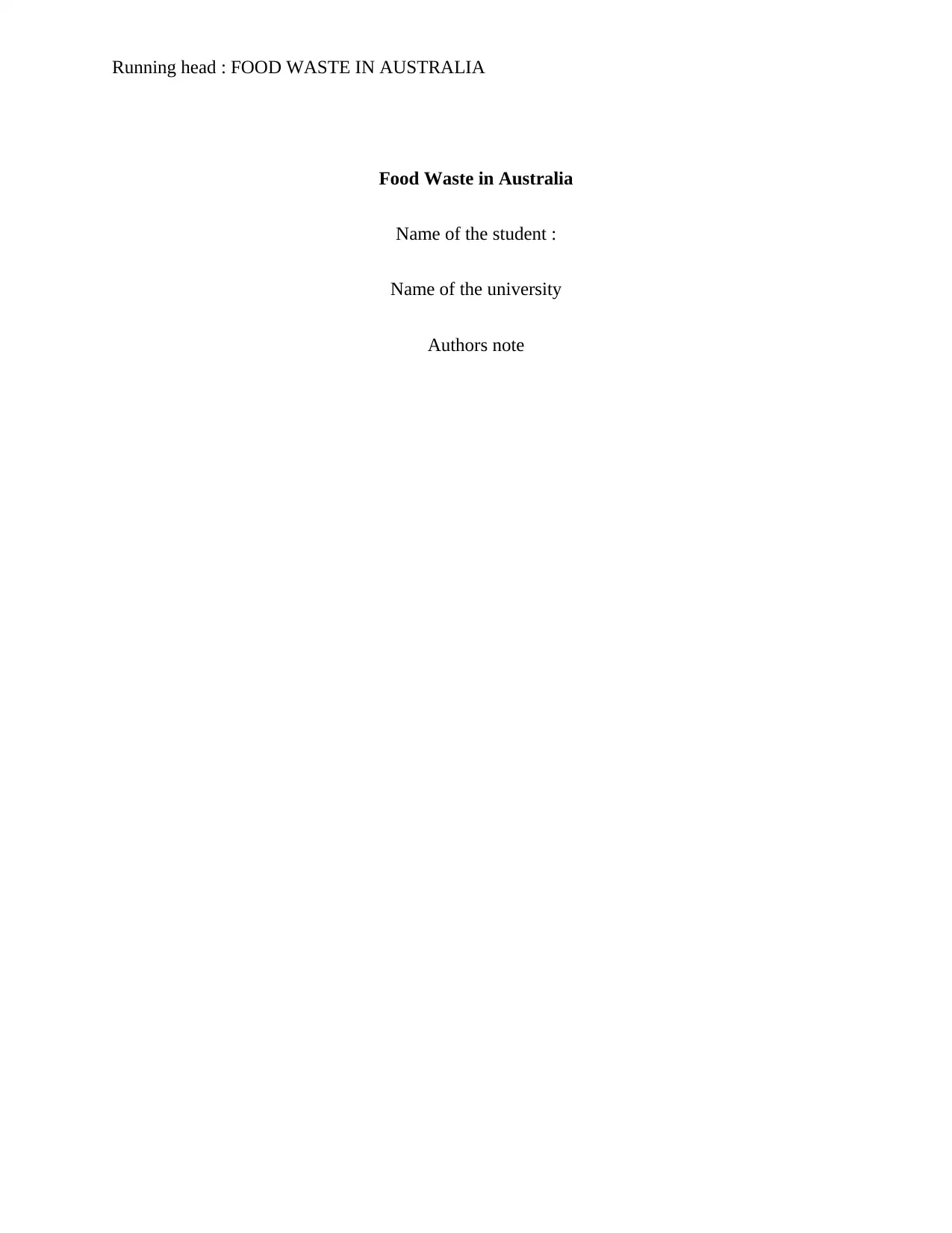
Running head : FOOD WASTE IN AUSTRALIA
Food Waste in Australia
Name of the student :
Name of the university
Authors note
Food Waste in Australia
Name of the student :
Name of the university
Authors note
Paraphrase This Document
Need a fresh take? Get an instant paraphrase of this document with our AI Paraphraser

1FOOD WASTE IN AUSTRALIA
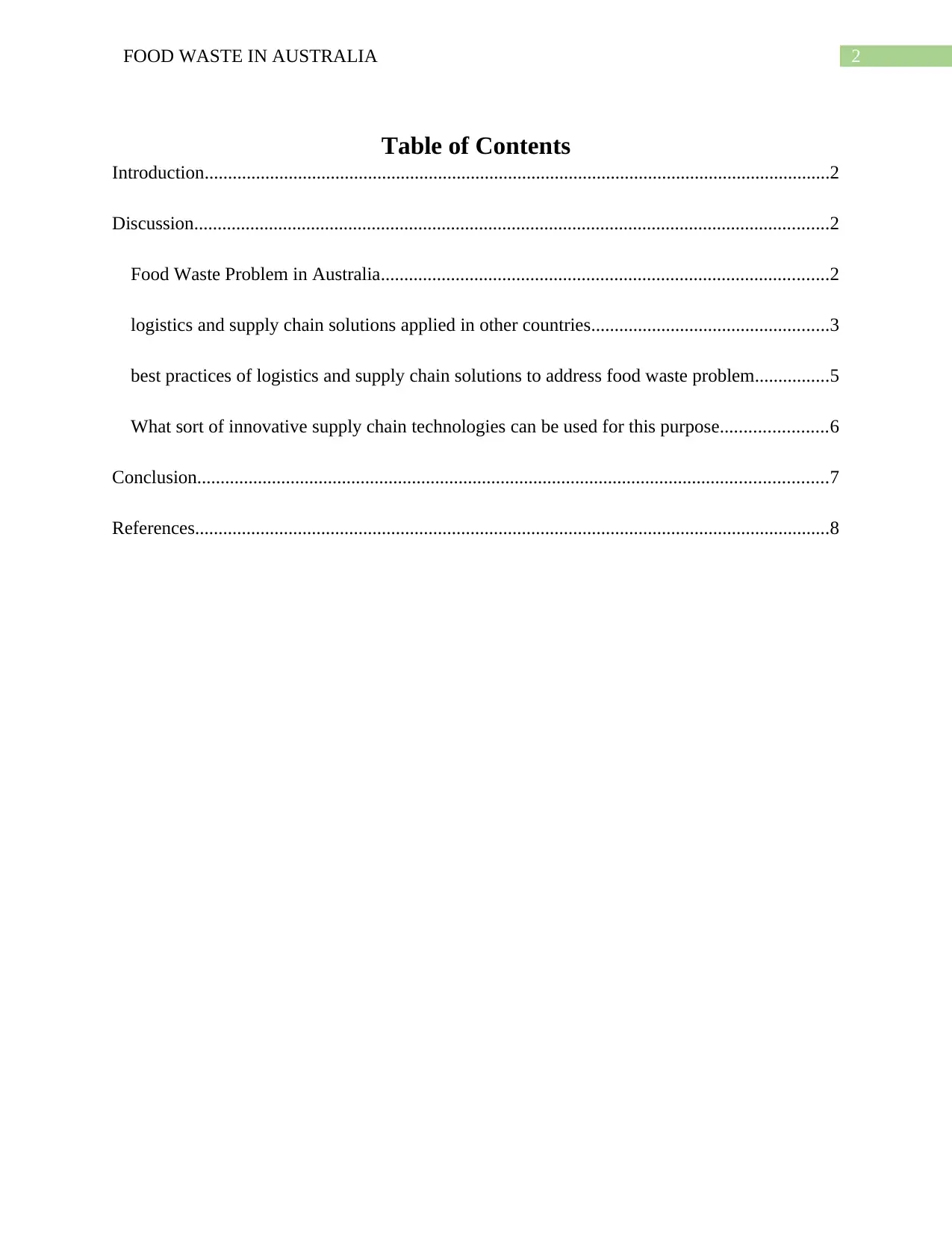
2FOOD WASTE IN AUSTRALIA
Table of Contents
Introduction......................................................................................................................................2
Discussion........................................................................................................................................2
Food Waste Problem in Australia................................................................................................2
logistics and supply chain solutions applied in other countries...................................................3
best practices of logistics and supply chain solutions to address food waste problem................5
What sort of innovative supply chain technologies can be used for this purpose.......................6
Conclusion.......................................................................................................................................7
References........................................................................................................................................8
Table of Contents
Introduction......................................................................................................................................2
Discussion........................................................................................................................................2
Food Waste Problem in Australia................................................................................................2
logistics and supply chain solutions applied in other countries...................................................3
best practices of logistics and supply chain solutions to address food waste problem................5
What sort of innovative supply chain technologies can be used for this purpose.......................6
Conclusion.......................................................................................................................................7
References........................................................................................................................................8
⊘ This is a preview!⊘
Do you want full access?
Subscribe today to unlock all pages.

Trusted by 1+ million students worldwide
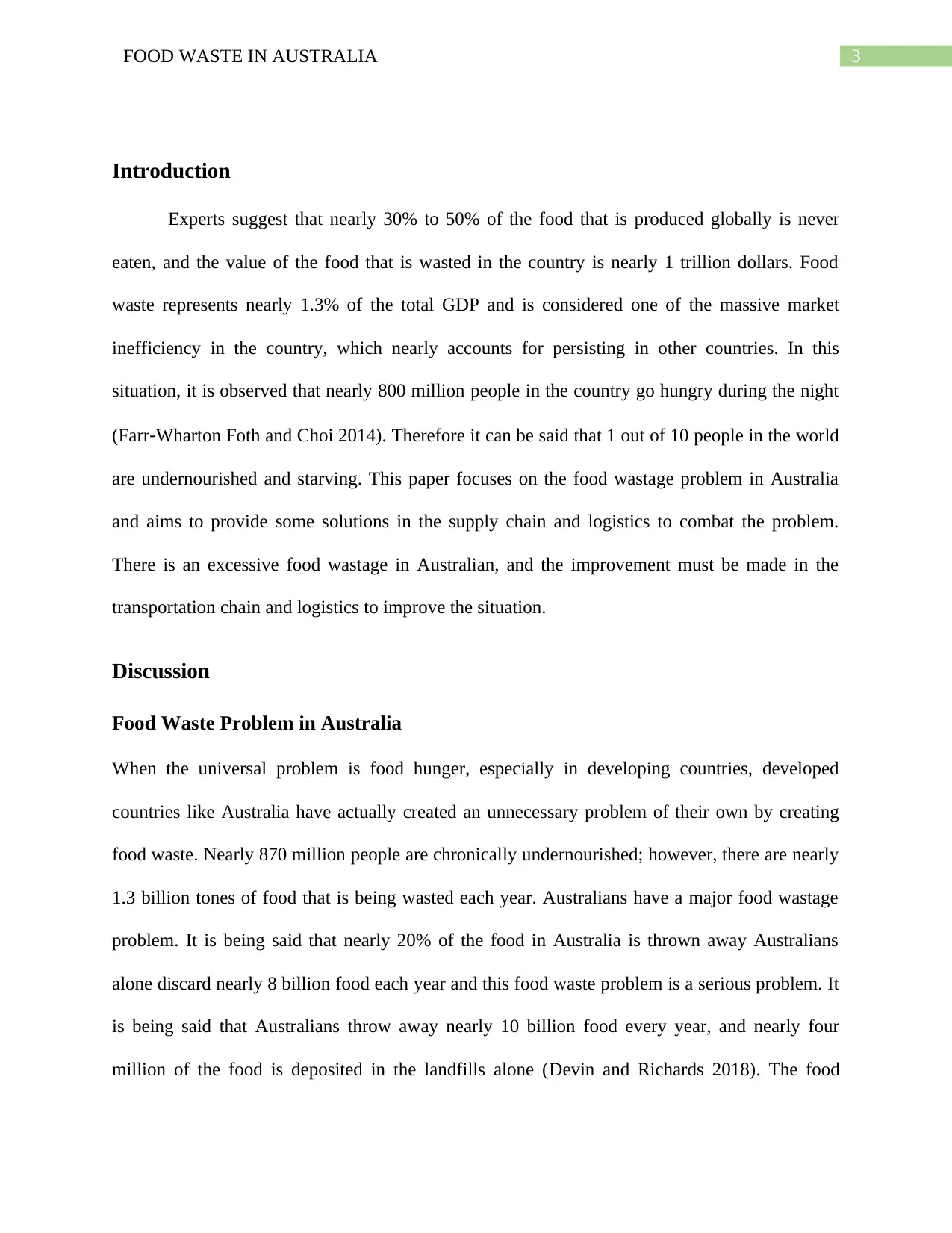
3FOOD WASTE IN AUSTRALIA
Introduction
Experts suggest that nearly 30% to 50% of the food that is produced globally is never
eaten, and the value of the food that is wasted in the country is nearly 1 trillion dollars. Food
waste represents nearly 1.3% of the total GDP and is considered one of the massive market
inefficiency in the country, which nearly accounts for persisting in other countries. In this
situation, it is observed that nearly 800 million people in the country go hungry during the night
(Farr‐Wharton Foth and Choi 2014). Therefore it can be said that 1 out of 10 people in the world
are undernourished and starving. This paper focuses on the food wastage problem in Australia
and aims to provide some solutions in the supply chain and logistics to combat the problem.
There is an excessive food wastage in Australian, and the improvement must be made in the
transportation chain and logistics to improve the situation.
Discussion
Food Waste Problem in Australia
When the universal problem is food hunger, especially in developing countries, developed
countries like Australia have actually created an unnecessary problem of their own by creating
food waste. Nearly 870 million people are chronically undernourished; however, there are nearly
1.3 billion tones of food that is being wasted each year. Australians have a major food wastage
problem. It is being said that nearly 20% of the food in Australia is thrown away Australians
alone discard nearly 8 billion food each year and this food waste problem is a serious problem. It
is being said that Australians throw away nearly 10 billion food every year, and nearly four
million of the food is deposited in the landfills alone (Devin and Richards 2018). The food
Introduction
Experts suggest that nearly 30% to 50% of the food that is produced globally is never
eaten, and the value of the food that is wasted in the country is nearly 1 trillion dollars. Food
waste represents nearly 1.3% of the total GDP and is considered one of the massive market
inefficiency in the country, which nearly accounts for persisting in other countries. In this
situation, it is observed that nearly 800 million people in the country go hungry during the night
(Farr‐Wharton Foth and Choi 2014). Therefore it can be said that 1 out of 10 people in the world
are undernourished and starving. This paper focuses on the food wastage problem in Australia
and aims to provide some solutions in the supply chain and logistics to combat the problem.
There is an excessive food wastage in Australian, and the improvement must be made in the
transportation chain and logistics to improve the situation.
Discussion
Food Waste Problem in Australia
When the universal problem is food hunger, especially in developing countries, developed
countries like Australia have actually created an unnecessary problem of their own by creating
food waste. Nearly 870 million people are chronically undernourished; however, there are nearly
1.3 billion tones of food that is being wasted each year. Australians have a major food wastage
problem. It is being said that nearly 20% of the food in Australia is thrown away Australians
alone discard nearly 8 billion food each year and this food waste problem is a serious problem. It
is being said that Australians throw away nearly 10 billion food every year, and nearly four
million of the food is deposited in the landfills alone (Devin and Richards 2018). The food
Paraphrase This Document
Need a fresh take? Get an instant paraphrase of this document with our AI Paraphraser
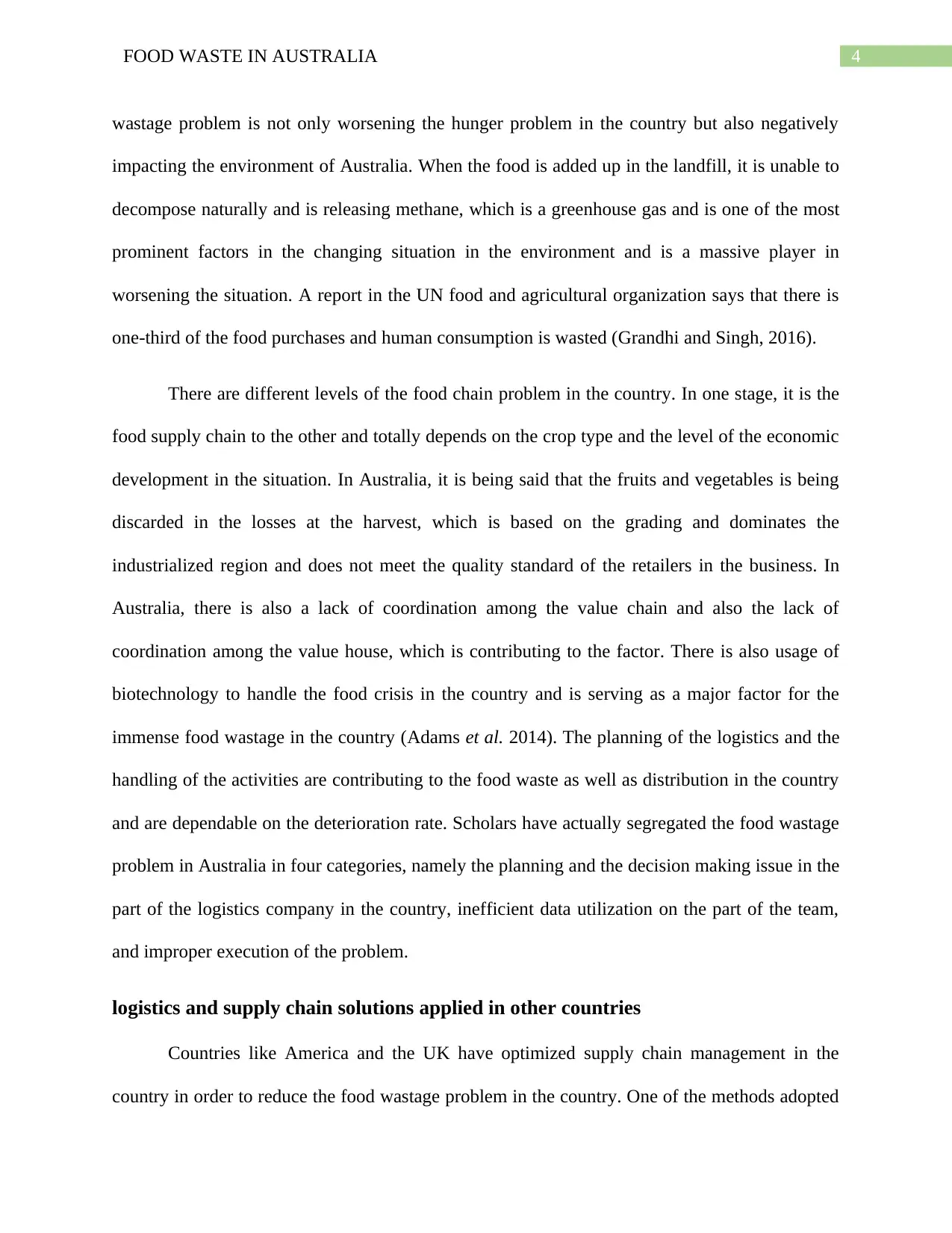
4FOOD WASTE IN AUSTRALIA
wastage problem is not only worsening the hunger problem in the country but also negatively
impacting the environment of Australia. When the food is added up in the landfill, it is unable to
decompose naturally and is releasing methane, which is a greenhouse gas and is one of the most
prominent factors in the changing situation in the environment and is a massive player in
worsening the situation. A report in the UN food and agricultural organization says that there is
one-third of the food purchases and human consumption is wasted (Grandhi and Singh, 2016).
There are different levels of the food chain problem in the country. In one stage, it is the
food supply chain to the other and totally depends on the crop type and the level of the economic
development in the situation. In Australia, it is being said that the fruits and vegetables is being
discarded in the losses at the harvest, which is based on the grading and dominates the
industrialized region and does not meet the quality standard of the retailers in the business. In
Australia, there is also a lack of coordination among the value chain and also the lack of
coordination among the value house, which is contributing to the factor. There is also usage of
biotechnology to handle the food crisis in the country and is serving as a major factor for the
immense food wastage in the country (Adams et al. 2014). The planning of the logistics and the
handling of the activities are contributing to the food waste as well as distribution in the country
and are dependable on the deterioration rate. Scholars have actually segregated the food wastage
problem in Australia in four categories, namely the planning and the decision making issue in the
part of the logistics company in the country, inefficient data utilization on the part of the team,
and improper execution of the problem.
logistics and supply chain solutions applied in other countries
Countries like America and the UK have optimized supply chain management in the
country in order to reduce the food wastage problem in the country. One of the methods adopted
wastage problem is not only worsening the hunger problem in the country but also negatively
impacting the environment of Australia. When the food is added up in the landfill, it is unable to
decompose naturally and is releasing methane, which is a greenhouse gas and is one of the most
prominent factors in the changing situation in the environment and is a massive player in
worsening the situation. A report in the UN food and agricultural organization says that there is
one-third of the food purchases and human consumption is wasted (Grandhi and Singh, 2016).
There are different levels of the food chain problem in the country. In one stage, it is the
food supply chain to the other and totally depends on the crop type and the level of the economic
development in the situation. In Australia, it is being said that the fruits and vegetables is being
discarded in the losses at the harvest, which is based on the grading and dominates the
industrialized region and does not meet the quality standard of the retailers in the business. In
Australia, there is also a lack of coordination among the value chain and also the lack of
coordination among the value house, which is contributing to the factor. There is also usage of
biotechnology to handle the food crisis in the country and is serving as a major factor for the
immense food wastage in the country (Adams et al. 2014). The planning of the logistics and the
handling of the activities are contributing to the food waste as well as distribution in the country
and are dependable on the deterioration rate. Scholars have actually segregated the food wastage
problem in Australia in four categories, namely the planning and the decision making issue in the
part of the logistics company in the country, inefficient data utilization on the part of the team,
and improper execution of the problem.
logistics and supply chain solutions applied in other countries
Countries like America and the UK have optimized supply chain management in the
country in order to reduce the food wastage problem in the country. One of the methods adopted
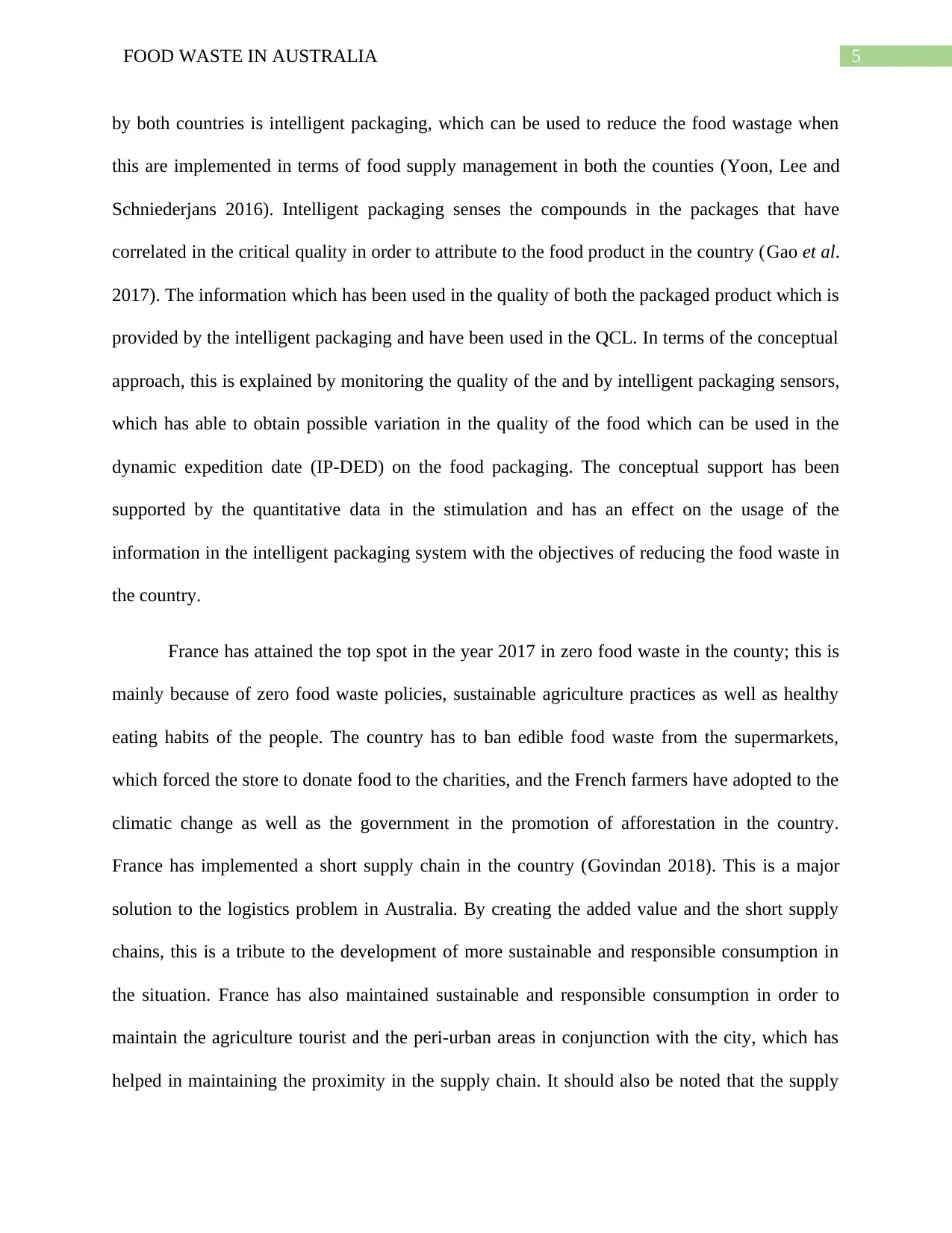
5FOOD WASTE IN AUSTRALIA
by both countries is intelligent packaging, which can be used to reduce the food wastage when
this are implemented in terms of food supply management in both the counties (Yoon, Lee and
Schniederjans 2016). Intelligent packaging senses the compounds in the packages that have
correlated in the critical quality in order to attribute to the food product in the country (Gao et al.
2017). The information which has been used in the quality of both the packaged product which is
provided by the intelligent packaging and have been used in the QCL. In terms of the conceptual
approach, this is explained by monitoring the quality of the and by intelligent packaging sensors,
which has able to obtain possible variation in the quality of the food which can be used in the
dynamic expedition date (IP-DED) on the food packaging. The conceptual support has been
supported by the quantitative data in the stimulation and has an effect on the usage of the
information in the intelligent packaging system with the objectives of reducing the food waste in
the country.
France has attained the top spot in the year 2017 in zero food waste in the county; this is
mainly because of zero food waste policies, sustainable agriculture practices as well as healthy
eating habits of the people. The country has to ban edible food waste from the supermarkets,
which forced the store to donate food to the charities, and the French farmers have adopted to the
climatic change as well as the government in the promotion of afforestation in the country.
France has implemented a short supply chain in the country (Govindan 2018). This is a major
solution to the logistics problem in Australia. By creating the added value and the short supply
chains, this is a tribute to the development of more sustainable and responsible consumption in
the situation. France has also maintained sustainable and responsible consumption in order to
maintain the agriculture tourist and the peri-urban areas in conjunction with the city, which has
helped in maintaining the proximity in the supply chain. It should also be noted that the supply
by both countries is intelligent packaging, which can be used to reduce the food wastage when
this are implemented in terms of food supply management in both the counties (Yoon, Lee and
Schniederjans 2016). Intelligent packaging senses the compounds in the packages that have
correlated in the critical quality in order to attribute to the food product in the country (Gao et al.
2017). The information which has been used in the quality of both the packaged product which is
provided by the intelligent packaging and have been used in the QCL. In terms of the conceptual
approach, this is explained by monitoring the quality of the and by intelligent packaging sensors,
which has able to obtain possible variation in the quality of the food which can be used in the
dynamic expedition date (IP-DED) on the food packaging. The conceptual support has been
supported by the quantitative data in the stimulation and has an effect on the usage of the
information in the intelligent packaging system with the objectives of reducing the food waste in
the country.
France has attained the top spot in the year 2017 in zero food waste in the county; this is
mainly because of zero food waste policies, sustainable agriculture practices as well as healthy
eating habits of the people. The country has to ban edible food waste from the supermarkets,
which forced the store to donate food to the charities, and the French farmers have adopted to the
climatic change as well as the government in the promotion of afforestation in the country.
France has implemented a short supply chain in the country (Govindan 2018). This is a major
solution to the logistics problem in Australia. By creating the added value and the short supply
chains, this is a tribute to the development of more sustainable and responsible consumption in
the situation. France has also maintained sustainable and responsible consumption in order to
maintain the agriculture tourist and the peri-urban areas in conjunction with the city, which has
helped in maintaining the proximity in the supply chain. It should also be noted that the supply
⊘ This is a preview!⊘
Do you want full access?
Subscribe today to unlock all pages.

Trusted by 1+ million students worldwide
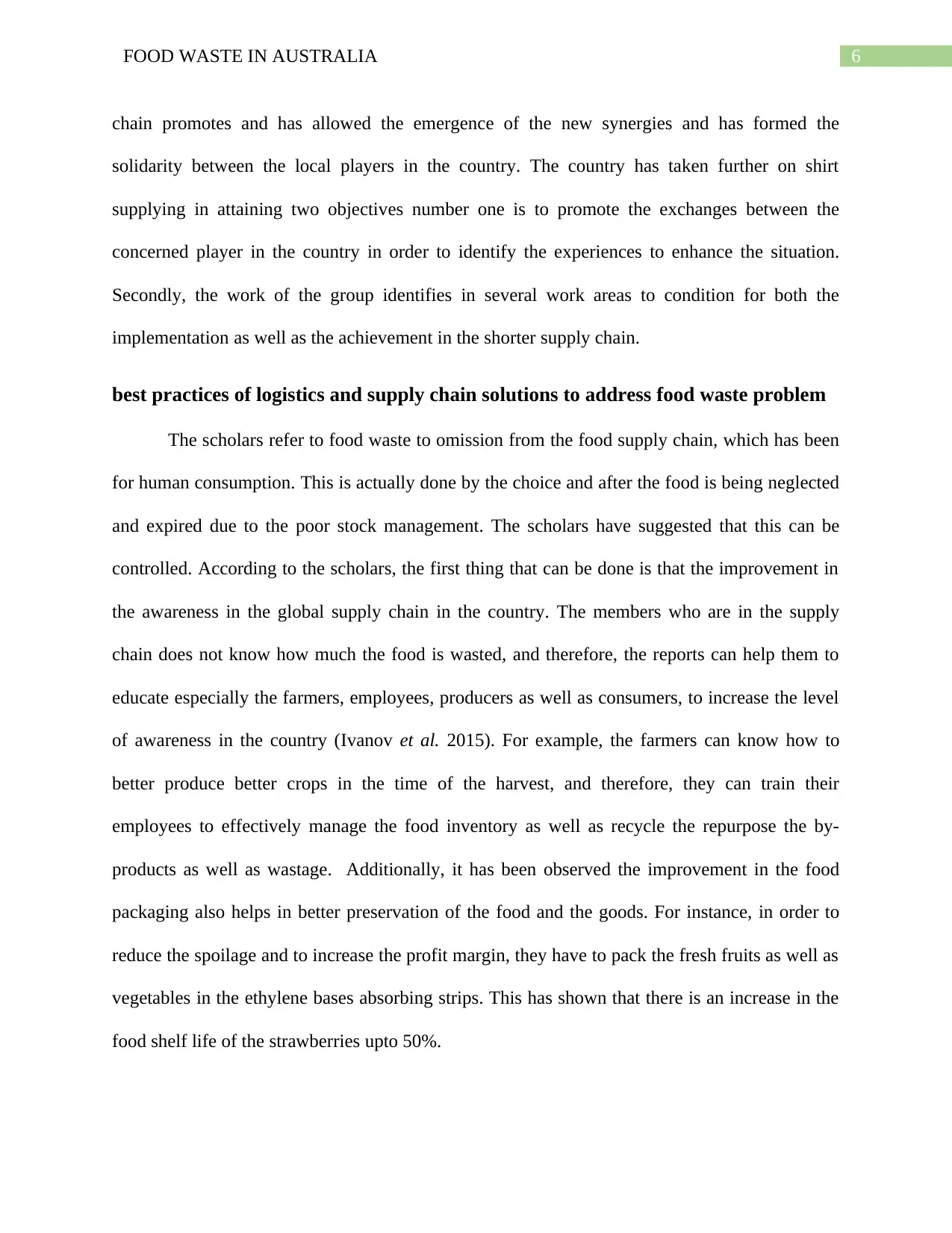
6FOOD WASTE IN AUSTRALIA
chain promotes and has allowed the emergence of the new synergies and has formed the
solidarity between the local players in the country. The country has taken further on shirt
supplying in attaining two objectives number one is to promote the exchanges between the
concerned player in the country in order to identify the experiences to enhance the situation.
Secondly, the work of the group identifies in several work areas to condition for both the
implementation as well as the achievement in the shorter supply chain.
best practices of logistics and supply chain solutions to address food waste problem
The scholars refer to food waste to omission from the food supply chain, which has been
for human consumption. This is actually done by the choice and after the food is being neglected
and expired due to the poor stock management. The scholars have suggested that this can be
controlled. According to the scholars, the first thing that can be done is that the improvement in
the awareness in the global supply chain in the country. The members who are in the supply
chain does not know how much the food is wasted, and therefore, the reports can help them to
educate especially the farmers, employees, producers as well as consumers, to increase the level
of awareness in the country (Ivanov et al. 2015). For example, the farmers can know how to
better produce better crops in the time of the harvest, and therefore, they can train their
employees to effectively manage the food inventory as well as recycle the repurpose the by-
products as well as wastage. Additionally, it has been observed the improvement in the food
packaging also helps in better preservation of the food and the goods. For instance, in order to
reduce the spoilage and to increase the profit margin, they have to pack the fresh fruits as well as
vegetables in the ethylene bases absorbing strips. This has shown that there is an increase in the
food shelf life of the strawberries upto 50%.
chain promotes and has allowed the emergence of the new synergies and has formed the
solidarity between the local players in the country. The country has taken further on shirt
supplying in attaining two objectives number one is to promote the exchanges between the
concerned player in the country in order to identify the experiences to enhance the situation.
Secondly, the work of the group identifies in several work areas to condition for both the
implementation as well as the achievement in the shorter supply chain.
best practices of logistics and supply chain solutions to address food waste problem
The scholars refer to food waste to omission from the food supply chain, which has been
for human consumption. This is actually done by the choice and after the food is being neglected
and expired due to the poor stock management. The scholars have suggested that this can be
controlled. According to the scholars, the first thing that can be done is that the improvement in
the awareness in the global supply chain in the country. The members who are in the supply
chain does not know how much the food is wasted, and therefore, the reports can help them to
educate especially the farmers, employees, producers as well as consumers, to increase the level
of awareness in the country (Ivanov et al. 2015). For example, the farmers can know how to
better produce better crops in the time of the harvest, and therefore, they can train their
employees to effectively manage the food inventory as well as recycle the repurpose the by-
products as well as wastage. Additionally, it has been observed the improvement in the food
packaging also helps in better preservation of the food and the goods. For instance, in order to
reduce the spoilage and to increase the profit margin, they have to pack the fresh fruits as well as
vegetables in the ethylene bases absorbing strips. This has shown that there is an increase in the
food shelf life of the strawberries upto 50%.
Paraphrase This Document
Need a fresh take? Get an instant paraphrase of this document with our AI Paraphraser
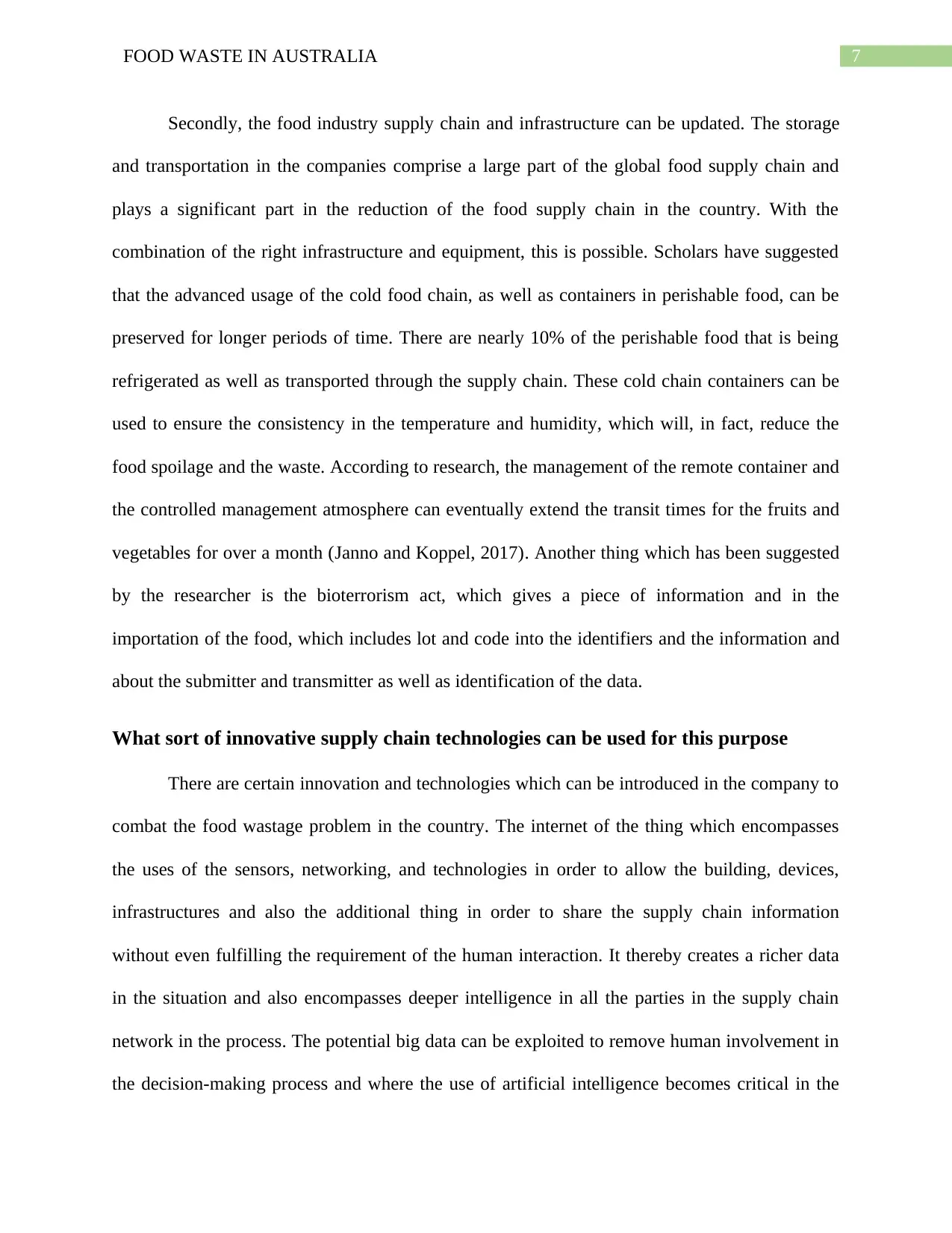
7FOOD WASTE IN AUSTRALIA
Secondly, the food industry supply chain and infrastructure can be updated. The storage
and transportation in the companies comprise a large part of the global food supply chain and
plays a significant part in the reduction of the food supply chain in the country. With the
combination of the right infrastructure and equipment, this is possible. Scholars have suggested
that the advanced usage of the cold food chain, as well as containers in perishable food, can be
preserved for longer periods of time. There are nearly 10% of the perishable food that is being
refrigerated as well as transported through the supply chain. These cold chain containers can be
used to ensure the consistency in the temperature and humidity, which will, in fact, reduce the
food spoilage and the waste. According to research, the management of the remote container and
the controlled management atmosphere can eventually extend the transit times for the fruits and
vegetables for over a month (Janno and Koppel, 2017). Another thing which has been suggested
by the researcher is the bioterrorism act, which gives a piece of information and in the
importation of the food, which includes lot and code into the identifiers and the information and
about the submitter and transmitter as well as identification of the data.
What sort of innovative supply chain technologies can be used for this purpose
There are certain innovation and technologies which can be introduced in the company to
combat the food wastage problem in the country. The internet of the thing which encompasses
the uses of the sensors, networking, and technologies in order to allow the building, devices,
infrastructures and also the additional thing in order to share the supply chain information
without even fulfilling the requirement of the human interaction. It thereby creates a richer data
in the situation and also encompasses deeper intelligence in all the parties in the supply chain
network in the process. The potential big data can be exploited to remove human involvement in
the decision-making process and where the use of artificial intelligence becomes critical in the
Secondly, the food industry supply chain and infrastructure can be updated. The storage
and transportation in the companies comprise a large part of the global food supply chain and
plays a significant part in the reduction of the food supply chain in the country. With the
combination of the right infrastructure and equipment, this is possible. Scholars have suggested
that the advanced usage of the cold food chain, as well as containers in perishable food, can be
preserved for longer periods of time. There are nearly 10% of the perishable food that is being
refrigerated as well as transported through the supply chain. These cold chain containers can be
used to ensure the consistency in the temperature and humidity, which will, in fact, reduce the
food spoilage and the waste. According to research, the management of the remote container and
the controlled management atmosphere can eventually extend the transit times for the fruits and
vegetables for over a month (Janno and Koppel, 2017). Another thing which has been suggested
by the researcher is the bioterrorism act, which gives a piece of information and in the
importation of the food, which includes lot and code into the identifiers and the information and
about the submitter and transmitter as well as identification of the data.
What sort of innovative supply chain technologies can be used for this purpose
There are certain innovation and technologies which can be introduced in the company to
combat the food wastage problem in the country. The internet of the thing which encompasses
the uses of the sensors, networking, and technologies in order to allow the building, devices,
infrastructures and also the additional thing in order to share the supply chain information
without even fulfilling the requirement of the human interaction. It thereby creates a richer data
in the situation and also encompasses deeper intelligence in all the parties in the supply chain
network in the process. The potential big data can be exploited to remove human involvement in
the decision-making process and where the use of artificial intelligence becomes critical in the
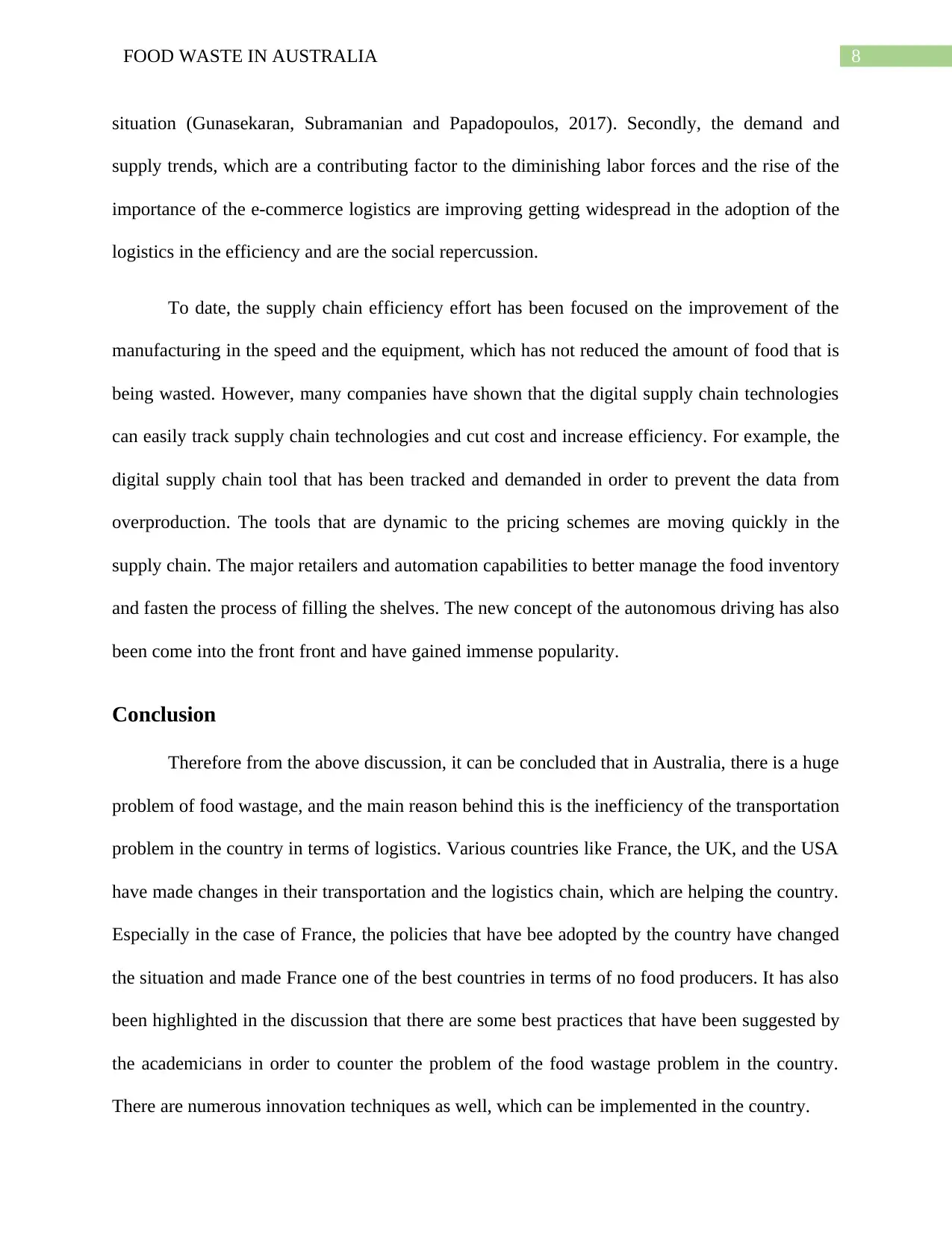
8FOOD WASTE IN AUSTRALIA
situation (Gunasekaran, Subramanian and Papadopoulos, 2017). Secondly, the demand and
supply trends, which are a contributing factor to the diminishing labor forces and the rise of the
importance of the e-commerce logistics are improving getting widespread in the adoption of the
logistics in the efficiency and are the social repercussion.
To date, the supply chain efficiency effort has been focused on the improvement of the
manufacturing in the speed and the equipment, which has not reduced the amount of food that is
being wasted. However, many companies have shown that the digital supply chain technologies
can easily track supply chain technologies and cut cost and increase efficiency. For example, the
digital supply chain tool that has been tracked and demanded in order to prevent the data from
overproduction. The tools that are dynamic to the pricing schemes are moving quickly in the
supply chain. The major retailers and automation capabilities to better manage the food inventory
and fasten the process of filling the shelves. The new concept of the autonomous driving has also
been come into the front front and have gained immense popularity.
Conclusion
Therefore from the above discussion, it can be concluded that in Australia, there is a huge
problem of food wastage, and the main reason behind this is the inefficiency of the transportation
problem in the country in terms of logistics. Various countries like France, the UK, and the USA
have made changes in their transportation and the logistics chain, which are helping the country.
Especially in the case of France, the policies that have bee adopted by the country have changed
the situation and made France one of the best countries in terms of no food producers. It has also
been highlighted in the discussion that there are some best practices that have been suggested by
the academicians in order to counter the problem of the food wastage problem in the country.
There are numerous innovation techniques as well, which can be implemented in the country.
situation (Gunasekaran, Subramanian and Papadopoulos, 2017). Secondly, the demand and
supply trends, which are a contributing factor to the diminishing labor forces and the rise of the
importance of the e-commerce logistics are improving getting widespread in the adoption of the
logistics in the efficiency and are the social repercussion.
To date, the supply chain efficiency effort has been focused on the improvement of the
manufacturing in the speed and the equipment, which has not reduced the amount of food that is
being wasted. However, many companies have shown that the digital supply chain technologies
can easily track supply chain technologies and cut cost and increase efficiency. For example, the
digital supply chain tool that has been tracked and demanded in order to prevent the data from
overproduction. The tools that are dynamic to the pricing schemes are moving quickly in the
supply chain. The major retailers and automation capabilities to better manage the food inventory
and fasten the process of filling the shelves. The new concept of the autonomous driving has also
been come into the front front and have gained immense popularity.
Conclusion
Therefore from the above discussion, it can be concluded that in Australia, there is a huge
problem of food wastage, and the main reason behind this is the inefficiency of the transportation
problem in the country in terms of logistics. Various countries like France, the UK, and the USA
have made changes in their transportation and the logistics chain, which are helping the country.
Especially in the case of France, the policies that have bee adopted by the country have changed
the situation and made France one of the best countries in terms of no food producers. It has also
been highlighted in the discussion that there are some best practices that have been suggested by
the academicians in order to counter the problem of the food wastage problem in the country.
There are numerous innovation techniques as well, which can be implemented in the country.
⊘ This is a preview!⊘
Do you want full access?
Subscribe today to unlock all pages.

Trusted by 1+ million students worldwide

9FOOD WASTE IN AUSTRALIA
Paraphrase This Document
Need a fresh take? Get an instant paraphrase of this document with our AI Paraphraser
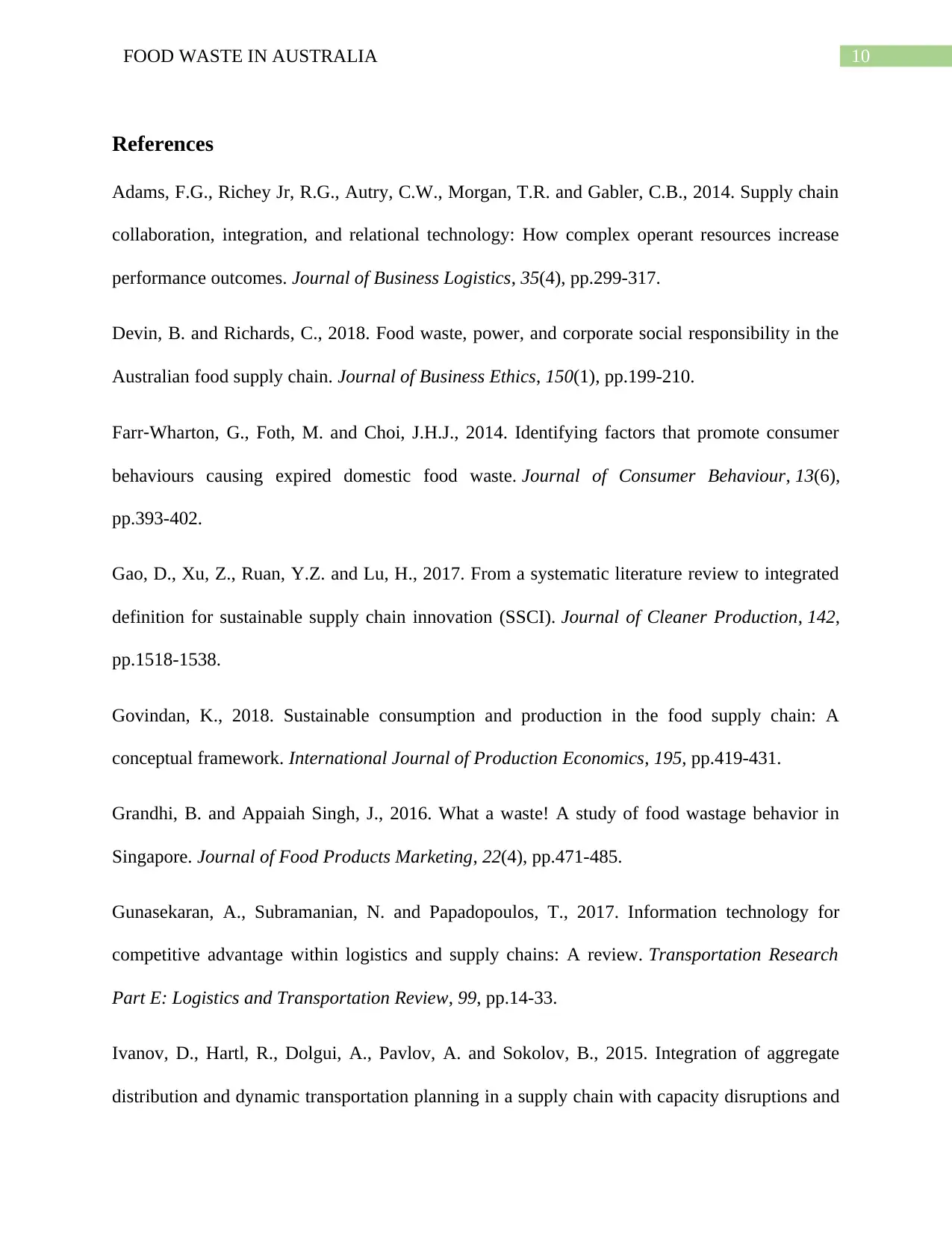
10FOOD WASTE IN AUSTRALIA
References
Adams, F.G., Richey Jr, R.G., Autry, C.W., Morgan, T.R. and Gabler, C.B., 2014. Supply chain
collaboration, integration, and relational technology: How complex operant resources increase
performance outcomes. Journal of Business Logistics, 35(4), pp.299-317.
Devin, B. and Richards, C., 2018. Food waste, power, and corporate social responsibility in the
Australian food supply chain. Journal of Business Ethics, 150(1), pp.199-210.
Farr‐Wharton, G., Foth, M. and Choi, J.H.J., 2014. Identifying factors that promote consumer
behaviours causing expired domestic food waste. Journal of Consumer Behaviour, 13(6),
pp.393-402.
Gao, D., Xu, Z., Ruan, Y.Z. and Lu, H., 2017. From a systematic literature review to integrated
definition for sustainable supply chain innovation (SSCI). Journal of Cleaner Production, 142,
pp.1518-1538.
Govindan, K., 2018. Sustainable consumption and production in the food supply chain: A
conceptual framework. International Journal of Production Economics, 195, pp.419-431.
Grandhi, B. and Appaiah Singh, J., 2016. What a waste! A study of food wastage behavior in
Singapore. Journal of Food Products Marketing, 22(4), pp.471-485.
Gunasekaran, A., Subramanian, N. and Papadopoulos, T., 2017. Information technology for
competitive advantage within logistics and supply chains: A review. Transportation Research
Part E: Logistics and Transportation Review, 99, pp.14-33.
Ivanov, D., Hartl, R., Dolgui, A., Pavlov, A. and Sokolov, B., 2015. Integration of aggregate
distribution and dynamic transportation planning in a supply chain with capacity disruptions and
References
Adams, F.G., Richey Jr, R.G., Autry, C.W., Morgan, T.R. and Gabler, C.B., 2014. Supply chain
collaboration, integration, and relational technology: How complex operant resources increase
performance outcomes. Journal of Business Logistics, 35(4), pp.299-317.
Devin, B. and Richards, C., 2018. Food waste, power, and corporate social responsibility in the
Australian food supply chain. Journal of Business Ethics, 150(1), pp.199-210.
Farr‐Wharton, G., Foth, M. and Choi, J.H.J., 2014. Identifying factors that promote consumer
behaviours causing expired domestic food waste. Journal of Consumer Behaviour, 13(6),
pp.393-402.
Gao, D., Xu, Z., Ruan, Y.Z. and Lu, H., 2017. From a systematic literature review to integrated
definition for sustainable supply chain innovation (SSCI). Journal of Cleaner Production, 142,
pp.1518-1538.
Govindan, K., 2018. Sustainable consumption and production in the food supply chain: A
conceptual framework. International Journal of Production Economics, 195, pp.419-431.
Grandhi, B. and Appaiah Singh, J., 2016. What a waste! A study of food wastage behavior in
Singapore. Journal of Food Products Marketing, 22(4), pp.471-485.
Gunasekaran, A., Subramanian, N. and Papadopoulos, T., 2017. Information technology for
competitive advantage within logistics and supply chains: A review. Transportation Research
Part E: Logistics and Transportation Review, 99, pp.14-33.
Ivanov, D., Hartl, R., Dolgui, A., Pavlov, A. and Sokolov, B., 2015. Integration of aggregate
distribution and dynamic transportation planning in a supply chain with capacity disruptions and
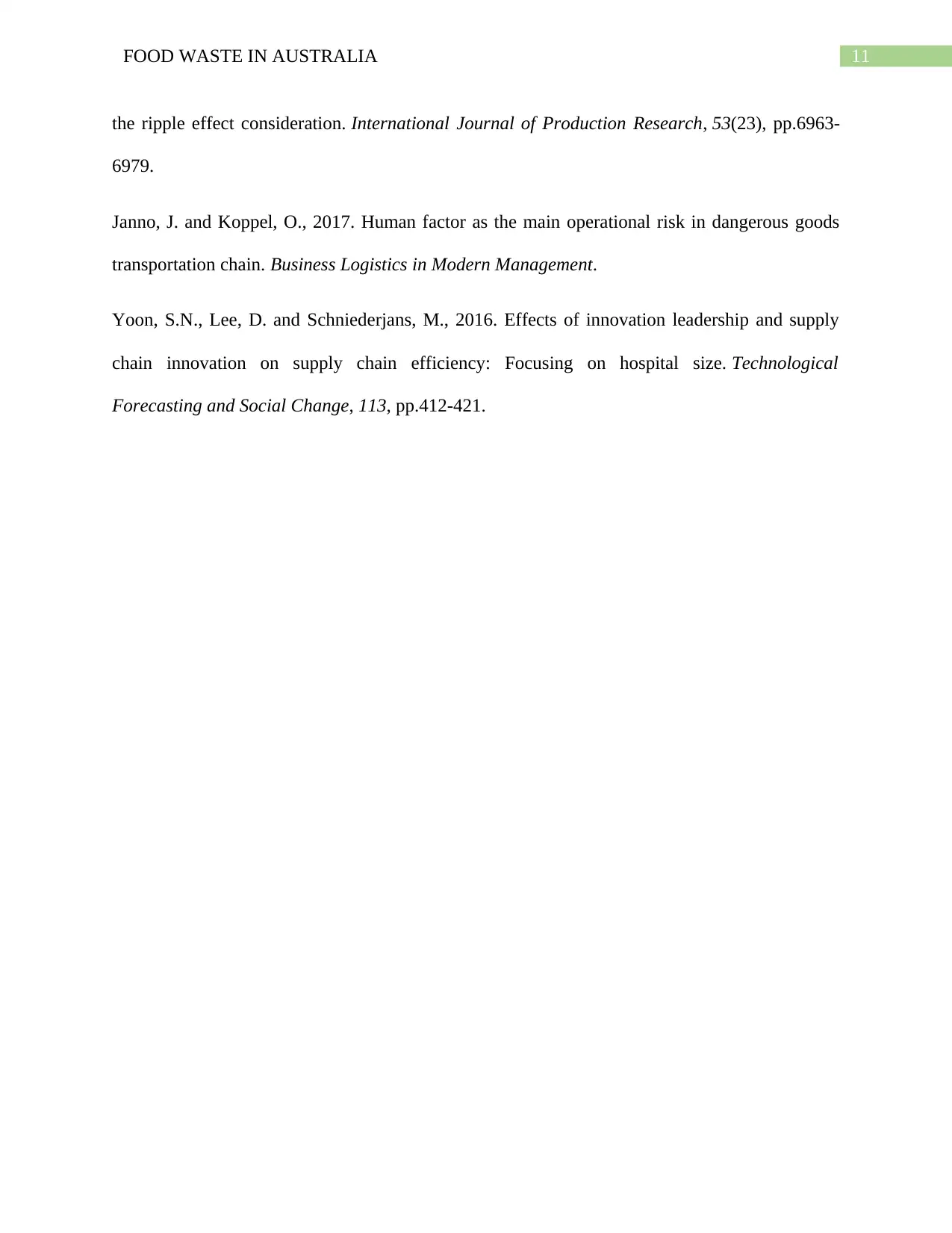
11FOOD WASTE IN AUSTRALIA
the ripple effect consideration. International Journal of Production Research, 53(23), pp.6963-
6979.
Janno, J. and Koppel, O., 2017. Human factor as the main operational risk in dangerous goods
transportation chain. Business Logistics in Modern Management.
Yoon, S.N., Lee, D. and Schniederjans, M., 2016. Effects of innovation leadership and supply
chain innovation on supply chain efficiency: Focusing on hospital size. Technological
Forecasting and Social Change, 113, pp.412-421.
the ripple effect consideration. International Journal of Production Research, 53(23), pp.6963-
6979.
Janno, J. and Koppel, O., 2017. Human factor as the main operational risk in dangerous goods
transportation chain. Business Logistics in Modern Management.
Yoon, S.N., Lee, D. and Schniederjans, M., 2016. Effects of innovation leadership and supply
chain innovation on supply chain efficiency: Focusing on hospital size. Technological
Forecasting and Social Change, 113, pp.412-421.
⊘ This is a preview!⊘
Do you want full access?
Subscribe today to unlock all pages.

Trusted by 1+ million students worldwide
1 out of 12
Related Documents
Your All-in-One AI-Powered Toolkit for Academic Success.
+13062052269
info@desklib.com
Available 24*7 on WhatsApp / Email
![[object Object]](/_next/static/media/star-bottom.7253800d.svg)
Unlock your academic potential
Copyright © 2020–2025 A2Z Services. All Rights Reserved. Developed and managed by ZUCOL.





